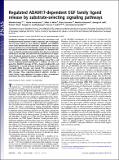| dc.contributor.author | Dang, Michelle | |
| dc.contributor.author | Armbruster, Nicole | |
| dc.contributor.author | Miller, Miles Aaron | |
| dc.contributor.author | Cermeno, Efrain A. | |
| dc.contributor.author | Hartmann, Monika | |
| dc.contributor.author | Bell, George W. | |
| dc.contributor.author | Root, David E. | |
| dc.contributor.author | Herrlich, Andreas | |
| dc.contributor.author | Lauffenburger, Douglas A | |
| dc.contributor.author | Lodish, Harvey F | |
| dc.date.accessioned | 2014-02-14T15:52:11Z | |
| dc.date.available | 2014-02-14T15:52:11Z | |
| dc.date.issued | 2013-05 | |
| dc.date.submitted | 2013-04 | |
| dc.identifier.issn | 0027-8424 | |
| dc.identifier.issn | 1091-6490 | |
| dc.identifier.uri | http://hdl.handle.net/1721.1/84949 | |
| dc.description.abstract | Ectodomain cleavage of cell-surface proteins by A disintegrin and metalloproteinases (ADAMs) is highly regulated, and its dysregulation has been linked to many diseases. ADAM10 and ADAM17 cleave most disease-relevant substrates. Broad-spectrum metalloprotease inhibitors have failed clinically, and targeting the cleavage of a specific substrate has remained impossible. It is therefore necessary to identify signaling intermediates that determine substrate specificity of cleavage. We show here that phorbol ester or angiotensin II-induced proteolytic release of EGF family members may not require a significant increase in ADAM17 protease activity. Rather, inducers activate a signaling pathway using PKC-α and the PKC-regulated protein phosphatase 1 inhibitor 14D that is required for ADAM17 cleavage of TGF-α, heparin-binding EGF, and amphiregulin. A second pathway involving PKC-δ is required for neuregulin (NRG) cleavage, and, indeed, PKC-δ phosphorylation of serine 286 in the NRG cytosolic domain is essential for induced NRG cleavage. Thus, signaling-mediated substrate selection is clearly distinct from regulation of enzyme activity, an important mechanism that offers itself for application in disease. | en_US |
| dc.description.sponsorship | National Institute of Diabetes and Digestive and Kidney Diseases (U.S.) (Grant R00DK077731) | en_US |
| dc.description.sponsorship | National Institute of Diabetes and Digestive and Kidney Diseases (U.S.) (Grant R01-CA96504) | en_US |
| dc.language.iso | en_US | |
| dc.publisher | National Academy of Sciences (U.S.) | en_US |
| dc.relation.isversionof | http://dx.doi.org/10.1073/pnas.1307478110 | en_US |
| dc.rights | Article is made available in accordance with the publisher's policy and may be subject to US copyright law. Please refer to the publisher's site for terms of use. | en_US |
| dc.source | PNAS | en_US |
| dc.title | Regulated ADAM17-dependent EGF family ligand release by substrate-selecting signaling pathways | en_US |
| dc.type | Article | en_US |
| dc.identifier.citation | Dang, M., N. Armbruster, M. A. Miller, E. Cermeno, M. Hartmann, G. W. Bell, D. E. Root, D. A. Lauffenburger, H. F. Lodish, and A. Herrlich. “Regulated ADAM17-dependent EGF family ligand release by substrate-selecting signaling pathways.” Proceedings of the National Academy of Sciences 110, no. 24 (June 11, 2013): 9776-9781. © 2013 National Academy of Sciences. | en_US |
| dc.contributor.department | Massachusetts Institute of Technology. Department of Biological Engineering | en_US |
| dc.contributor.department | Massachusetts Institute of Technology. Department of Biology | en_US |
| dc.contributor.mitauthor | Dang, Michelle | en_US |
| dc.contributor.mitauthor | Miller, Miles Aaron | en_US |
| dc.contributor.mitauthor | Cermeno, Efrain A. | en_US |
| dc.contributor.mitauthor | Bell, George W. | en_US |
| dc.contributor.mitauthor | Lauffenburger, Douglas A. | en_US |
| dc.contributor.mitauthor | Lodish, Harvey F. | en_US |
| dc.contributor.mitauthor | Herrlich, Andreas | en_US |
| dc.relation.journal | Proceedings of the National Academy of Sciences | en_US |
| dc.eprint.version | Final published version | en_US |
| dc.type.uri | http://purl.org/eprint/type/JournalArticle | en_US |
| eprint.status | http://purl.org/eprint/status/PeerReviewed | en_US |
| dspace.orderedauthors | Dang, M.; Armbruster, N.; Miller, M. A.; Cermeno, E.; Hartmann, M.; Bell, G. W.; Root, D. E.; Lauffenburger, D. A.; Lodish, H. F.; Herrlich, A. | en_US |
| dc.identifier.orcid | https://orcid.org/0000-0002-7029-7415 | |
| mit.license | PUBLISHER_POLICY | en_US |
| mit.metadata.status | Complete | |
